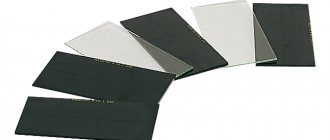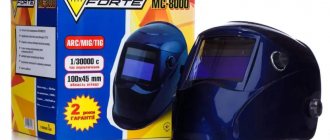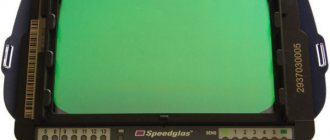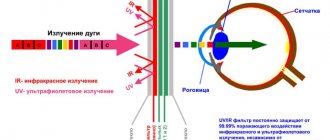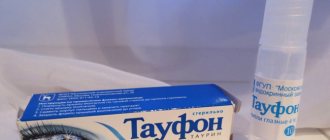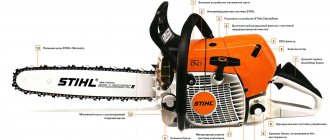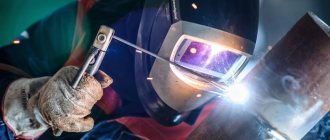Chameleon type welding helmets are so named because the light filter automatically changes the degree of darkness depending on the intensity of the light flux. This is much more convenient than a regular shield or an old type mask with a replaceable filter. Having put on the chameleon, you can clearly see everything even before you start welding: the filter is almost transparent and does not interfere with your work. When the arc is ignited, it darkens in a matter of seconds, protecting your eyes from burns. After the arc goes out, it becomes transparent again. You can carry out all the necessary manipulations without removing the mask, which is much more convenient than raising and lowering the protective shield and much better than holding the shield in your hand. But a wide selection of different priced items can be confusing: what is the difference, and which one is better? We'll tell you how to choose a chameleon mask below.
Chameleon welding masks come in a wide variety. Choosing is not an easy task at all. Moreover, it is not so much the appearance that is important, but the quality indicators
Principle of operation
Automatic darkening of the “chameleon” mask is ensured by the presence of light filters made on the basis of liquid crystals. The property of liquid crystals to orient themselves in space under the influence of electrical voltage determines the operating principle of the mask.
In the normal state, when there is no serious light exposure on the screen, the crystals are in a position that allows daylight to pass freely through the screen. When the welding arc is ignited, a sensor is triggered , transmitting a signal to the electronic unit . After processing the signal by the electronic device, a command is given to rearrange the position of the crystals . They change their structure, which makes the screen dark (light radiation is blocked by the screen).
The duration of the crystal restructuring process takes a period of time no more than ten thousandths of a second . Almost instantaneous darkening makes it possible to keep the mask on throughout the entire length of the intermittent weld. After completing the welding work, it is possible to set a delay on the mask for the end of the screen darkening . This provides eye protection from the bright light of a weld that has not yet cooled down.
In high-quality and therefore expensive “chameleon” masks, the light filter has a multi-layer structure . The more layers, the more evenly the shading is distributed across the surface of the screen. The filter includes a separate layer that protects against ultraviolet and infrared radiation.
Light filter in a chameleon: what is it and which is better
That small glass that is installed on the welding helmet is a real miracle of science and technology. It contains the latest achievements in optics, microelectronics, liquid crystals and solar energy. This is the “glass”. In fact, this is a whole multi-layered cake, which consists of the following elements:
- liquid crystal cells (several layers - the more, the better);
Approximate composition of an automatic light filter in a chameleon welding mask (To increase the size of the picture, right-click on it) - UV filter;
- infrared filter;
- polarizing films;
- welding arc detection sensors (from 2 to 4, there are also them, the more, the better);
- protective glass;
- batteries (solar batteries and/or lithium batteries).
The main and main advantage of a chameleon welding mask is that even if it did not have time to work, it will not let in ultraviolet and infrared radiation (if the mask was lowered). And the degree of protection from these harmful effects does not depend in any way on the settings. In any case and with any settings, you are protected from these types of harmful influences.
But this is only if the “pie” contains the appropriate filters and they are of the proper quality. Since it is impossible to check this without special devices, you have to rely on certificates. And masks must have them. Moreover, on the territory of Russia only two centers can issue them: VNIIS and the Federal State Budgetary Institution at the All-Russian Research Institute of Labor Protection and Economics. To be sure that the certificate is genuine, its number can be found on the official website of the Federal Service for Accreditation at this link.
This is a form on the Rossaccreditation website for checking the certificate. You can fill in only the number, leaving all other fields empty (To increase the size of the picture, right-click on it)
The certificate number is entered in the appropriate field and you receive the validity date, information about the applicant, and the manufacturer. A small note: the abbreviation RPE stands for “optical personal protective equipment.” This is what a welder's mask is called in bureaucratic language.
If such a certificate exists, the following message will appear. By clicking on the link you will see the text of the certificate (To enlarge the image size, right-click on it)
The most important thing is that you make sure that this product (by the way, compare both the name and model) is safe for your health.
You may be interested in how to make a gazebo on a metal frame.
Classification of automatic welding filters
Since the light filter and its quality are the key element in this product, you should start choosing a chameleon mask with it. All its indicators are classified according to the EN379 standard and must be displayed on its surface through a fraction.
One of the filters in the chameleon mask. Its classification is indicated in red
Now let’s take a closer look at what is hidden behind these numbers and what they should be. Each position can contain a number from 1, 2, 3. Accordingly, “1” is the best option - first class, “3” is the worst - third class. Now let’s talk about which position displays which characteristic and what it means.
Explanation of EN37 classification
Optical class
It reflects how clearly and without distortion the picture will be visible to you through the filter. Depends on the quality of the protective glass (film) used and the build quality. If "1" comes first, distortion will be minimal. If the values are higher, you will see everything as if through a crooked glass.
Light scattering
Depends on the purity and quality of the optical crystals used. Shows the degree of “turbidity” of the transmitted picture. You can compare it with wet car glass: as long as there are no oncoming traffic, the drops hardly interfere. As soon as a light source appears, everything blurs. To avoid this effect, it is necessary that the second position be “1”.
Uniformity or Homogeneity
Shows how evenly the filter is shaded in different parts. If there is a unit in the third position, the difference can be no more than 0.1 DIN, 2 - 0.2 DIN, 3 - 0.3 DIN. It is clear that it will be more comfortable with uniform darkening.
Angular dependence
Reflects the dependence of dimming on viewing angle. Here, too, the best value is “1” - the first class changes the darkening by no more than 1 DIN, the second by 2 DIN and the third by 3 DIN.
This is what the difference between a high-quality mask and a not-so-good filter looks like in real life.
From all this it is clear that the more units in the filter characteristic, the more comfortable you will be working in a mask. This is what you need to focus on when choosing a chameleon welder mask. Professionals prefer at least the following parameters: 1/1/1/2. Such masks are expensive, but even after working for a long time, your eyes will not get tired in them.
Amateur welders, for occasional work, can get by with simpler filters, but class 3 is considered a thing of the past. Therefore, it’s probably not worth buying masks with such filters.
And one moment. Sellers usually call this entire classification with one term “Optical class”. It’s just that this formulation quite accurately reflects the essence of all the characteristics.
Adjustments of the SpeedGlass chameleon welding helmet (SpeedGlas)
There are several more chameleon settings that allow you to adjust the dimming mode for a given situation. They can be located inside, on the light filter, or they can be placed outside in the form of handles on the left on the side surface of the mask. These are the following parameters:
- Dimming adjustment. Allows you to change the current dimming level. You can make it lighter/darker without interrupting your work if the control is located outside. If it is located inside, you will need to stop, remove the mask and tighten the adjuster. For non-professionals, this is normal: they don’t need development. But even the pros don’t always like external adjustments: they can hit something.
The controls themselves can be in the form of switches, wheels, or can be made in the form of touch switches - Adjusting sensitivity. It is located inside the mask, on the filter. With its help, you can set what the filter will work on: only on the arc, or also on bright light sources. If you work indoors, you can set the sensitivity to high: the filter will darken when an arc occurs. Since there are no other variable light sources, it will not twitch. On the street, with high sensitivity, it can also respond to sun glare. So here you have to reduce the sensitivity.
- Delay in mask clearing. It is necessary to prevent the eyes from receiving light shock from the hot metal after welding is completed. If there is no delay, the filter immediately becomes lighter and the bright glow of the weld pool hits the eyes. It is not dangerous or fatal, but unpleasant. The dimming delay allows you to “push back” the moment of filter brightening for some time. Also, this delay prevents the filter from clearing if you cook with arc separation or if the electrode sticks. So adjustment is necessary.
You may be interested in reading about the types of welds and joints, welding techniques and methods used.
How to check without welding
Important! You need to know that to check the functionality of the automatic mask filter without welding, you need to use a light source with unstable radiation.
- The filter reacts well to the spark of a flint lighter. Just for the spark, not for the burning flame.
- A conventional incandescent lamp operates on alternating current at a frequency of 50 Hz. A person does not notice this, but an automatic filter picks up the vibrations and darkens the screen.
- The TV control panel or the glowing smartphone screen covers only a small fraction of the spectrum perceived by the light filter. This is mainly infrared radiation, to which one of many layers reacts.
Some advanced chameleon masks have a “TEST” button , designed to test the quality of the filters. They are functional if, after pressing it for a certain time, the mask screen darkens.
Types of masks and characteristics
But, nevertheless, despite its minor shortcomings, the chameleon mask conquered the market and became the most popular protection for welders.
Any welding helmet, including chameleon, is divided into types according to optical parameters:
- Optical class. This is a value indicating the quality of the manufactured filter glasses and the assembly as a whole. The higher the indicator, the better the image and the less image distortion.
- Light scattering. Roughly speaking, this is the transparency of the glass. A higher indicator in the marking gives greater light transmittance.
- Homogeneity. This is a uniform darkening over the entire surface of the filter.
- Angular degree of darkness. Depending on the angle of the light filter to the place of work, the darkening of the mask glasses also changes.
All four indicators are indicated in markings located directly on the filter. They are designated as n/n/n/n. Each value has an indicator from 1 to 3. Moreover, the lower the number, the higher the indicator of each of the points.
Chameleon masks also have such indicators as: the speed of turning on protection and enlightenment, as well as the sensitivity of the sensors.
Turn-on speed is very important for chameleon masks. Light propagates instantly, which means the filter must darken in thousandths of a second. And for ease of operation, the optics must be quickly cleared.
The main indicator will be the degree of darkening, since it is this that protects vision from bright glare. It is characterized by an indicator from 4 to 13. The lower the number, the more transparent the filter.
Types of adjustments
The following basic parameters are subject to adjustment of the chameleon mask.
Adjusting the position of the mask on the head. Reliable fixation of the mask on the head is carried out using a handle located at the back of the head and a belt passing through the top of the head.
Selecting the optimal distance from the eyes to the filter. There are latches on the mask, by loosening which you can move the filter closer or further to the eyes . After choosing the optimal distance, you should not forget about securing the clamps.
Select the dimming level. By rotating the wheel located outside the mask, the darkening mode is selected . The scale indicates levels from 0 to 16 according to the European DIN standard , where the sixteenth will have the maximum darkness. Despite the existence of all kinds of tables, each welder approaches the choice of darkening intensity in his own way, as well as the choice of the electrode and welding current.
Adjusting sensitivity. This adjustment allows you to select the optimal filter threshold . During the welding process, you can rotate the wheel to select the on/off mode, not only taking into account the intensity of the welding arc radiation. The sensitivity of the filter is influenced by the radiation of the molten metal, glare from the welding of a neighbor - a welder, and other light sources.
Adjustment of delay time. Welding technologies leave behind seams with varying degrees of cooling rates. After welding with a high current, the deposited mass will cool for a long time, and a short weld made at a low current will cool very quickly. The opening of the filter in the first case will be with a greater time delay, in the second it will open almost immediately.
Switch for “Welding-Grinding” mode
The mode of switching from welding to metal grinding without removing the mask from the head is very convenient even in modern Chameleon welding masks. In this case, the mask serves to protect the welder's eyes both from harmful ultraviolet radiation and from deposits that can get into the eyes when cleaning metal.
A special lever on the Chameleon mask allows you to quickly activate the grinding mode and, conversely, welding metals, without resorting to anything unnecessary for these purposes. The lever allows you to disable the arc detection function and use the mask as a regular metal shield.
However, after finishing working with metal, do not forget about this and put it in the reverse position.
How to use
The rules for using the chameleon mask are indicated in the instructions supplied with it.
Before starting work with a new mask, remove the film from the protective plate . For used ones, check for visible damage.
Check the functionality of the light filters using one of the methods indicated in the section of this article “How to check without welding.”
Adjust the parameters specified in the “Types of adjustments” section of the article. The settings must be appropriate for the nature of the work being performed.
Welding work must be carried out at temperatures from 15°C to 55°C.
The use of the mask in plasma and gas welding is limited.
It is not recommended to leave the mask shield on heated surfaces.
Strong blows to the shield are contraindicated.
You cannot use spare parts for repairs that are not specified in the user manual.
If the mask does not perform the basic functions of darkening the screen, you should stop welding and look for the cause of the malfunction.
Avoid getting moisture on the filter. This may disable it.
The use of chemical detergents and solvents for cleaning is prohibited . It is recommended to wipe the filter elements with a soft, clean, lint-free cloth.
When the red light on the filter turns on, you need to replace the batteries . Replace it after switching to open screen mode.
The protection plate should be changed regularly. Droplets from molten metal cause pitting, cracks, and ultimately clouding of the screen.
Contacting the service center
Additional options make repairs more difficult and increase the risk of mask failure. If the degree of darkening has decreased significantly, it is necessary to inspect the structure.
Some components cannot be repaired and require mandatory replacement. If you cannot do this yourself, you need to contact a service center. The guarantee is valid only for complete masks. If you managed to delve into it, you will have to pay for the service.
There is no point in undertaking repairs to the system board: this is a matter for professionals. It is better to contact the service center immediately. Unsuccessful DIY repairs can result in additional costs.
How to adjust the mask, auto darkening degree
The author of the following video, a practicing welder and at the same time a talented teacher, shows in an accessible form how to adjust the parameters of the chameleon mask. An inexpensive Chinese-made mask is used as a sample.
A specific example shows how to choose the optimal darkening. It is emphasized that with proper adjustment, a small area of the heat-affected zone should be visible. The advantage of the video is that it contains a table of correspondence between the dimming parameters and the current strength of the welding operation being performed. The values in the table are recommended; the author draws attention to the effect of dimming the vision of the welder on the setting.
Briefly, but very clearly, the process of selecting the delay time for opening the screen window after welding is described.
Setting the sensitivity or response threshold of a light filter causes difficulties for novice welders, because depends on external conditions. The author clearly explained why, due to incorrect sensitivity settings, you can “catch a bunny” (see the arc not through a darkened screen). The author's fundamental rule for adjusting sensitivity
A small drawback of the video is the lack of description of how to adjust the mask for convenient fixation on the welder’s head. Perhaps the author wanted to leave more time for summing up the results of the competition.
Instructions for using the Resanta MC2 protective mask
Before proceeding directly to welding work, you need to make sure that the light filters are turned on and their reaction to changes in lighting in the room. To perform this test, you need to put on a mask and then look at the lamp or the sun. If the dimming does not work, you need to check the wiring or replace the battery. After making sure that the dimming is working, you need to make the necessary settings. The choice of darkening power should be made based on the specific power of the welding equipment used. It is prohibited to remove the mask while performing welding work.
Why doesn’t it dim, doesn’t dim well and other faults
Chameleon protective masks, like any other welding equipment, do not last forever; they can break for various reasons. most frequently .
- There is no darkening of the filter screen for radiation from the welding arc . The main reason is a broken power supply. Dead batteries should be replaced; the batteries can be recharged from the mains. Some designs use solar panels to power the electronic unit. To replenish energy, they need to be sent directly to a light source for a certain time.
- Dirty protective glass causes the filter to flicker when reacting to the welding arc. It needs to be washed periodically. In case of severe mechanical damage, glass replacement is required.
- Budget options from some “manufacturers” suffer from poor dimming . Low technological discipline contributes to the ingress of dust particles onto the liquid crystal layers. Such crystals can no longer close completely over the entire working surface of the screen. Ineffective darkening will cause eye inflammation after intensive work with such a mask.
- Uneven darkening may cause a deviation in the horizontal position of the filter relative to the face. Eliminated by leveling the casing.
- The use of masks in cold winter conditions is not intended . The filter will darken slowly, making it impossible to provide effective eye protection.
- A common reason for poor visibility of the weld seam during operation arises from forgetting to remove the film from the protective glass .
- Water may get into the electronic unit . A mask with such a defect should be sent to professionals for repair.
- The weak point of some mask models is the contacts from the control unit to the light filter . They often break and the mask screen stops working. An example of the defect is described in the following video. The author claims that he eliminated the defect by soldering with a regular soldering iron in road conditions. Not overheating the filter during such a repair is a great success. The actual process of restoring contact is not shown in the video.
Possible malfunctions and methods for eliminating them
- The screen will not respond to light unless connected to a power supply. If the model is equipped with AAA alkaloid batteries or rechargeable batteries, charging indicators are displayed in the screen area. If the red light is on, it's time to replace the batteries. Solar panels are charged while welding. If the mask does not turn on, point it towards a light source for a few minutes.
- If the screen darkens unevenly, check the distance from it to both eyes. Perhaps while they were adjusting the mask and adjusting it to the head, the filter shifted. It should be parallel to the face. Loosen the clamps and align the casing.
- If the screen flickers during welding, it may be due to the outer glass. Sometimes it is enough to wash it. In case of mechanical damage (scratches, surface chips) it must be replaced. If the filter continues to act up, check the cleanliness of the sensor surface. When there are two operating modes (welding and grinding), check which position the switch is in. The screen may flicker when low-current welding in low sensitivity mode. The desired level can be established experimentally during operation.
- The filter does not darken immediately in the cold. Viewing screens quickly change the degree of darkness in the temperature range from +50 to -10°C; Chameleons are not intended for harsh winters.
- If the weld seam is difficult to see, there may be several reasons. Sometimes the film is forgotten on the protective glass. You can try cleaning it, switching the dimming control.
Work order, necessary tools
If the light filter of the chameleon mask does not work, it completely eliminates its protective functions. There are two options left: throw the mask in a landfill or try to repair it. Self-repair can be carried out by familiarizing yourself with the procedure for performing the work and the tools used and materials from the video.
The most common reason for the lack of dimming is the failure of the power supply . The author immediately determined that his round factory battery had run out. Still, it is better to make sure that there is no voltage on the contacts using, for example, a multimeter.
How to assemble a welding helmet - Machine tools, welding, metalworking
Every professional welder or DIYer who has to deal with this type of work knows how important it is to provide personal protection.
For example, using a high-quality and comfortable protective mask will greatly simplify the task.
It is worth noting that the use of a standard sample is not always possible, because the anthropometric data of each person is individual, so knowing how to make a welding mask with your own hands is worth it for everyone who is engaged in this difficult but important work.
Carrying out maintenance
Compliance with maintenance schedules will have a beneficial effect on the trouble-free operation of chameleon protective masks. While the filter is operating, dust and dirt collect . They must be removed at intervals of at least one month . When working in dusty conditions, for example, in enclosed areas of metallurgical plants, the filter must be cleaned every week .
Cleaning the light filter requires compliance with certain regulations . Only cotton, lint-free soft fabric is used as material . The detergent composition must be neutral and comply with the manufacturer’s recommendations. The use of abrasive and oil-containing products in cleaning technology is excluded. Dirt and dust should be washed off carefully, avoiding pressing hard on the surface of the filter.
TOP 5 chameleon masks in terms of price-quality ratio
As usual, I will give the TOP 5 best chameleon masks for purchase, which I consider optimal in terms of characteristics, quality and price. Don’t be afraid, I won’t list Speedglas products so as not to generate outrage about the cost in the comments. Although Speedglas masks are beyond praise. So, I think the best are:
- Fubag Ultima 11 - viewing window 100x49 mm, works with two photosensors, 3 DIN in the clear state, 11 DIN in the darkened state. Weighs only 425 g. One of the cheapest masks among those worthy of attention.
- Bars MS 307 Premium with ASF 777 - a huge viewing window of 100x100 mm gives a wide overview. Top class 1/1/1/1 lenses provide clear vision. True Color technology with real color reproduction is used. In the open position, the dimming is constant 4 DIN. When closed, the adjustment range is 5-13 DIN. The price of the mask is not exorbitant.
- Tecmen ADF 730S TM15 - designed to operate at temperatures from -10 to +55 degrees. Clear visibility thanks to high optical class 1/1/1/1. All controls are outside, so as not to be distracted by removing the mask while working. The light filter interacts with four sensors at once.
- ESAB Savage A40 is one of the most popular. By the way, my first mask. The dimensions of the viewing window are 100x50 mm, optical class 1/1/1/2. There is an external grinding mode button. Welding shade 9-13 DIN. Four sensors are built in. From experience I can say that the quality is excellent, the filter works clearly.
- Tecmen ADF 815S TM16 is a professional chameleon mask with 4 sensors, optical class 1/1/1/1, shade range 5-13 DIN and external grinding button. Designed for frost -10 degrees. Viewing window 97x62 mm.
Safety precautions
It is impossible to carry out welding work without a protective mask. In addition to visual impairment, you can burn your face and neck with ultraviolet rays, and damage your respiratory organs with hot harmful gases. A chameleon mask protects your eyes much better than a permanently darkened mask. Novice welders can “catch a bunny” using a regular mask without any problems while igniting the arc.
To further reduce the likelihood of eye injury when working with a chameleon mask, the following safety precautions should be followed:
- check mask settings;
- position of operating mode switches;
- availability of battery charge;
- check the darkening of the filter using the “TEST” button, a light bulb or a silicon lighter.
If before starting work it turns out that the mask is faulty, you should refuse to carry out welding work with it. It is better to throw all your efforts into fixing the breakdown. You should first think about health, and then about the quality of the weld.
Important! To maintain the functionality of the chameleon masks, light filters and solar panels should be stored in shaded places, in the absence of influence of light fluxes on them.
DIY welding mask
Every professional welder or DIYer who has to deal with this type of work knows how important it is to provide personal protection. For example, using a high-quality and comfortable protective mask will greatly simplify the task. It is worth noting that the use of a standard sample is not always possible, because the anthropometric data of each person is individual, so knowing how to make a welding mask with your own hands is worth it for everyone who is engaged in this difficult but important work.

